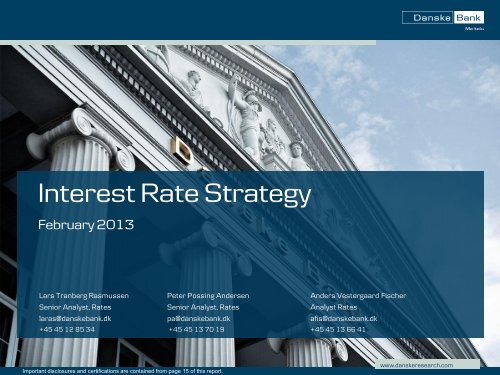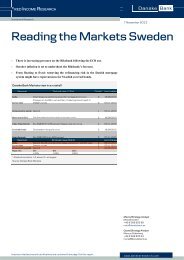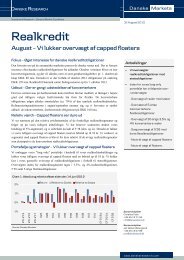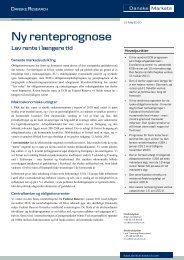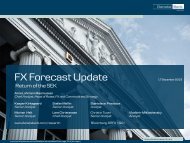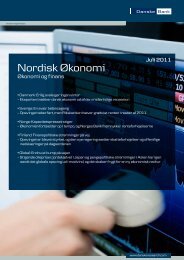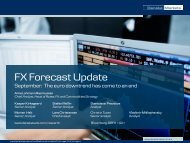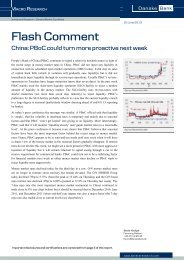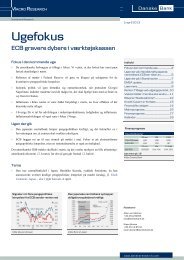Eur - Danske Analyse - Danske Bank
Eur - Danske Analyse - Danske Bank
Eur - Danske Analyse - Danske Bank
Create successful ePaper yourself
Turn your PDF publications into a flip-book with our unique Google optimized e-Paper software.
Interest Rate StrategyFebruary 2013Lars Tranberg Rasmussen Peter Possing Andersen Anders Vestergaard FischerSenior Analyst, Rates Senior Analyst, Rates Analyst Rateslaras@danskebank.dk pa@danskebank.dk afis@danskebank.dk+45 45 12 85 34 +45 45 13 70 19 +45 45 13 66 41Important disclosures and certifications are contained from page 15 of this report.www.danskeresearch.com
Initial announcement of the second 3Y LTRO due on Friday• Total 3Y LTRO repayment over the past four weeks is EUR149bn. However, excess liquidity has only declined EUR75bnto EUR506bn due to a significant decline in autonomous factors.• The EONIA O/N fixing has declined to around an all-time low and the EONIA trading volume remains low, suggestinglimited pick-up in interbank lending activity.• We judge that the market is discounting an initial repayment of the second 3Y LTRO close to EUR125bn (ann. 22 Feb,settles 27 Feb). This will lower excess liquidity to EUR380bn given no change in autonomous factors.• If we assume that the share repaid is equal to the initial repayment of the first 3Y LTRO, the initial repayment of thesecond 3Y LTRO would amount to EUR150bn. Note there is big uncertainty as to the exact amount repaid.• The current EONIA curve implies a decline in excess liquidity to below EUR100bn by year-end. This is broadlyconsistent with an initial repayment of EUR125bn and then a weekly repayment of EUR7bn towards the end of the year.On the other hand, the market is not pricing a full drain of excess liquidity by the expiration of the 3Y LTROs in Feb. 2015.Trading view:• For 2013 we believe a more gradual repayment profile is more likely. <strong>Eur</strong>o area banks will primarily use the initialoption to repay emergency loans. . Hence the market is pricing in too rapid an increase in EONIA O/N fixings during 2013in our view. Meanwhile we believe there is room for to price in faster normalisation of liquidity during 2014.• In sum, the market is pricing to steep an EONIA curve in 2013 and too flat an EONIA curve in 2014.• TRADE IDEA: Pay DEC14 IMM Eonia vs. receive DEC13 IMM Eonia (around. 27bp).www.danskeresearch.com2
3Y LTROs can now be repaid to the ECB at weekly auctions and excess liquidityis expected to decline towards zero from a peak at EUR800bn900 EUR bn EUR bn8009008007006005004003002001000Excess liquidity07 08 09 10 11 12 137006005004003002001000Source: <strong>Danske</strong> <strong>Bank</strong> MarketsNote1: Excess liquidity = Liquidity given through open market operations – (reserve requirements + published autonomous factors)Note2: Autonomous factors include factors of the central bank balance sheet, which affect the general liquidity in the banking sector, but aregenerally not under the control of the central bank.www.danskeresearch.com3
<strong>Eur</strong>o area banks repaid EUR149bn in the past four weeks, but excess liquidityonly declined EUR75bn as autonomous factors declined too1300120011001000900800700600500400300EUR bn>Reserverequirements >>500450400350300250200150100500Source: ECBwww.danskeresearch.com4
EONIA fixing unlikely to be affected before excess liquidity declines belowEUR200bn, so there is some way to go9008007006005004003002001000EUR bnECB rate corridor (Refi-depo) >>>09 10 11 12 13bp10075502500.70.60.50.40.30.20.10EONIA O/N - Deposit, %Excess liquidity, EUR bn0 200 400 600 800 1000Chg in excess liq < -EUR20bn/periodChg in excess liq > +EUR20bn/periodChg in excess liq between +/-EUR20bn/periodSource: <strong>Danske</strong> <strong>Bank</strong> MarketsEONIA O/N toincrease whenexcess liquiditybelow EUR200bnCurrent levelwww.danskeresearch.com5
Large uncertainty regarding initial repayment of second 3Y LTRONon-disclosed Italy Spain Belgium PortugalIreland Germany Greece France OthersGreece2%France2%Others5%EUR521bn500Germany4%Ireland5%Italy36%Portugal7%400Belgium9%300200Spain30%1000Non-disclosedSource: Bloomberg, <strong>Danske</strong> <strong>Bank</strong> MarketsEUR, bn Allotment Initial repay ShareLTRO-I 489 137 28%LTRO-II 530 148 28%Source: Bloomberg, <strong>Danske</strong> <strong>Bank</strong> Marketswww.danskeresearch.com6
Backing out excess liquidity from EONIA forward curve0.70%0.60%0.50%0.40%0.30%0.20%0.10%EONIA forward curve0.00%Feb 13 Aug 13 Feb 14 Aug 14 Feb 15ECB dates EONIA, current 01/02/13 10/01/13800700600500400300200100Implied excess liquidityEUR bn %Model implied excess liquidityEonia forward on ECB dates0.75%0.65%0.55%0.45%0.35%0.25%0.15%0.05%0-0.05%Feb 13 Aug 13 Feb 14 Aug 14 Feb 15EONIA forward curve less steep after 4 th repayment.Excess liquidity implied to decline to around EUR100bnby end-13. Only a gradual rise to 0.50% by end-14Source: <strong>Danske</strong> <strong>Bank</strong> Marketswww.danskeresearch.com8
Scenarios for normalisation of excess liquidity- The last EUR100bn of excess liquidity is the critical issue700EUR bnEUR bn70060060050050040040030030020020010010000Jan 13 Jul 13 Jan 14 Jul 14 Jan 15Slow Really fast Kink0.80.70.60.50.40.30.20.1%00Feb 13 Jun 13 Sep 13 Jan 14 May 14 Sep 14 Jan 15Really fast Market Slow Kink%0.80.70.60.50.40.30.20.1First 3Y LTRO:1st repayment: EUR137bn (EUR489bn) from 273 banks (523)2nd repayment: EUR3.5bn vs EUR30bn exp. (27 banks)3rd repayment: EUR5.0bn vs EUR3bn exp. (21 banks)4th repayment: EUR3.9bn vs EUR4bn exp (9 banks)Second 3Y LTRO:Initial announcement on second 3Y LTRO Friday 22 Feb 2013www.danskeresearch.com9
Should we be afraid of ECB exit?#1) The output gap is still very negative543210% %ECB refi rateModel ECB +6mEONIA 1m rateOut ofsample543210-198 00 02 04 06 08 10 12-1www.danskeresearch.com10
Should we be afraid of ECB exit?#2) There are no inflationary pressures in the euro area2.12.0Inflation forecasts 2-year ahead% y/y % y/y2.12.01.91.91.81.81.71.71.6ECB hikes1.61.500 02 04 06 08 10 121.5www.danskeresearch.com11
Should we be afraid of ECB exit?#3) Eonia market is still impairedwww.danskeresearch.com12
End of ECB easing and liquidity cycles- sometimes this causes a ”false-starting bear market”?www.danskeresearch.com13
DisclosureThis research report has been prepared by <strong>Danske</strong> <strong>Bank</strong> Markets, a division of <strong>Danske</strong> <strong>Bank</strong> A/S ('<strong>Danske</strong> <strong>Bank</strong>'). The authors of this research report are LarsTranberg Rasmussen (Senior Analyst), Peter Possing Andersen (Senior Analyst) and Anders Vestergård Fischer (Analyst).Analyst certificationEach research analyst responsible for the content of this research report certifies that the views expressed in the research report accurately reflect the researchanalyst’s personal view about the financial instruments and issuers covered by the research report. Each responsible research analyst further certifies that no partof the compensation of the research analyst was, is or will be, directly or indirectly, related to the specific recommendations expressed in the research report.Regulation<strong>Danske</strong> <strong>Bank</strong> is authorised and subject to regulation by the Danish Financial Supervisory Authority and is subject to the rules and regulation of the relevantregulators in all other jurisdictions where it conducts business. <strong>Danske</strong> <strong>Bank</strong> is subject to limited regulation by the Financial Services Authority (UK). Details on theextent of the regulation by the Financial Services Authority are available from <strong>Danske</strong> <strong>Bank</strong> upon request.The research reports of <strong>Danske</strong> <strong>Bank</strong> are prepared in accordance with the Danish Society of Financial Analysts’ rules of ethics and the recommendations of theDanish Securities Dealers Association.Conflicts of interest<strong>Danske</strong> <strong>Bank</strong> has established procedures to prevent conflicts of interest and to ensure the provision of high-quality research based on research objectivity andindependence. These procedures are documented in <strong>Danske</strong> <strong>Bank</strong>’s research policies. Employees within <strong>Danske</strong> <strong>Bank</strong>’s Research Departments have beeninstructed that any request that might impair the objectivity and independence of research shall be referred to Research Management and the ComplianceDepartment. <strong>Danske</strong> <strong>Bank</strong>’s Research Departments are organised independently from and do not report to other business areas within <strong>Danske</strong> <strong>Bank</strong>.Research analysts are remunerated in part based on the overall profitability of <strong>Danske</strong> <strong>Bank</strong>, which includes investment banking revenues, but do not receivebonuses or other remuneration linked to specific corporate finance or debt capital transactions.Financial models and/or methodology used in this research reportCalculations and presentations in this research report are based on standard econometric tools and methodology as well as publicly available statistics for eachindividual security, issuer and/or country. Documentation can be obtained from the authors upon request. Opinions in this research may differ from opinions in other<strong>Danske</strong> <strong>Bank</strong> research due to different time horizons or portfolio considerations.Risk warningMajor risks connected with recommendations or opinions in this research report, including as sensitivity analysis of relevant assumptions, are stated throughoutthe text.Date of first publicationSee the front page of this research report for the date of first publication.www.danskeresearch.com14
General disclaimerThis presentation has been prepared by <strong>Danske</strong> <strong>Bank</strong> Markets (a division of <strong>Danske</strong> <strong>Bank</strong> A/S). It is provided for informational purposes only and should be viewedsolely in conjunction with the oral presentation provided by <strong>Danske</strong> <strong>Bank</strong> Markets and/or <strong>Danske</strong> Markets Inc. It does not constitute or form part of, and shall underno circumstances be considered as, an offer to sell or a solicitation of an offer to purchase or sell any relevant financial instruments (i.e. financial instrumentsmentioned herein or other financial instruments of any issuer mentioned herein and/or options, warrants, rights or other interests with respect to any such financialinstruments) ('Relevant Financial Instruments').The presentation has been prepared independently and solely on the basis of publicly available information that <strong>Danske</strong> <strong>Bank</strong> considers to be reliable. Whilereasonable care has been taken to ensure that its contents are not untrue or misleading, no representation is made as to its accuracy or completeness and <strong>Danske</strong><strong>Bank</strong>, its affiliates and subsidiaries accept no liability whatsoever for any direct or consequential loss, including without limitation any loss of profits, arising fromreliance on this presentation.The opinions expressed herein are the opinions of the research analysts responsible for the presentation and reflect their judgement as of the date hereof. Theseopinions are subject to change and <strong>Danske</strong> <strong>Bank</strong> does not undertake to notify any recipient of this presentation of any such change nor of any other changes relatedto the information provided in the presentation.<strong>Danske</strong> <strong>Bank</strong>, its affiliates, subsidiaries and staff may perform services for or solicit business from any issuer mentioned herein and may hold long or short positionsin, or otherwise be interested in, the financial instruments mentioned herein. The Equity and Corporate Bonds analysts of <strong>Danske</strong> <strong>Bank</strong> and undertakings with whichthe Equity and Corporate Bonds analysts have close links are, however, not permitted to invest in financial instruments that are covered by the relevant Equity orCorporate Bonds analyst or the research sector to which the analyst is linked.<strong>Danske</strong> <strong>Bank</strong> is authorised and subject to regulation by the Danish Financial Supervisory Authority and is subject to the rules and regulation of the relevantregulators in all other jurisdictions where it conducts business. <strong>Danske</strong> <strong>Bank</strong> is subject to limited regulation by the Financial Services Authority (UK). Details on theextent of the regulation by the Financial Services Authority are available from <strong>Danske</strong> <strong>Bank</strong> on request.This presentation is not intended for retail customers in the United Kingdom or the United States.This presentation is protected by copyright and is intended solely for the designated addressee. It may not be reproduced or distributed, in whole or in part, by anyrecipient for any purpose without <strong>Danske</strong> <strong>Bank</strong>’s prior written consent.www.danskeresearch.com15
Disclaimer related to distribution in the United StatesIn the United States this presentation is presented by <strong>Danske</strong> <strong>Bank</strong> and/or <strong>Danske</strong> Markets Inc., a U.S. registered broker-dealer and subsidiary of <strong>Danske</strong> <strong>Bank</strong>. Inthe United States the presentation is intended solely to ‘U.S. institutional investors’ as defined in SEC Rule 15a-6.<strong>Danske</strong> <strong>Bank</strong> is not subject to U.S. rules with regard to the preparation of research reports and the independence of research analysts. In addition, the researchanalysts of <strong>Danske</strong> <strong>Bank</strong> who have prepared this presentation are not registered or qualified as research analysts with the NYSE or FINRA but satisfy the applicablerequirements of a non-U.S. jurisdiction.Any U.S. investor recipient of this presentation who wishes to purchase or sell any Relevant Financial Instrument may do so only by contacting <strong>Danske</strong> Markets Inc.directly and should be aware that investing in non-U.S. financial instruments may entail certain risks. Financial instruments of non-U.S. issuers may not be registeredwith the U.S. Securities and Exchange Commission and may not be subject to the reporting and auditing standards of the U.S. Securities and Exchange Commission.www.danskeresearch.com16


